The winter months are perfect for a visit: fewer day tourists, peace and quiet and spectacular lighting conditions for your souvenir photos that you don't have in summer. The temperatures are ideal for hiking with good shoes and weatherproof clothing (be careful of mud, wind or rain, but very rarely snow). Therefore I can only recommend a hike at the beginning of the year.
(about 20 km, duration about 6 hours)
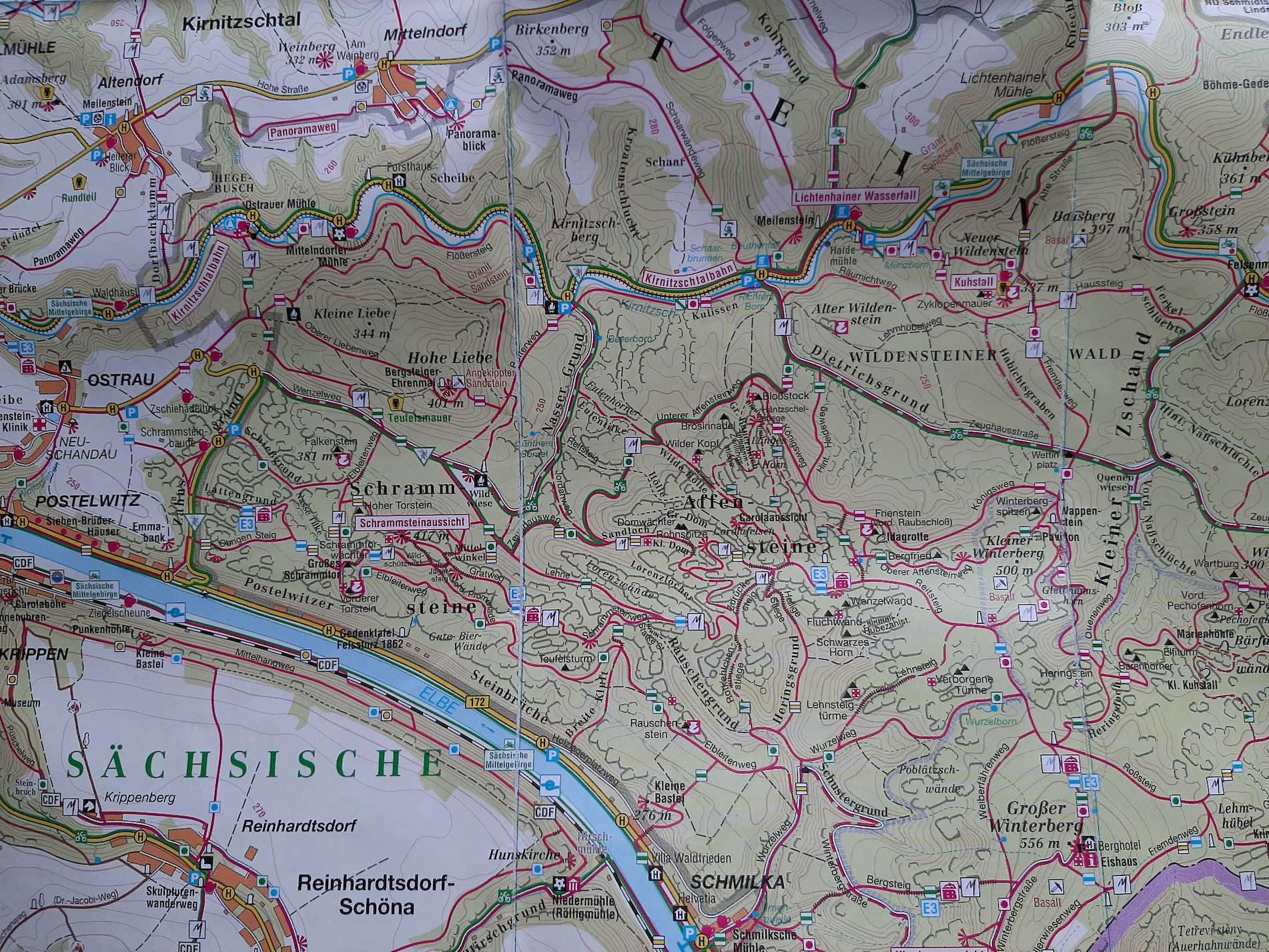
My Path: Town Bad Schandau - Lichtenhainer Waterfall - Cowshed (Kuhstall, red dot) - Cyclops Wall (Zyklopenmauer, red path) Fremdenweg (Part of the "Malerweg"- the Painters Path, red dot) - Dietrichsgrund - hinterer Heideweg - Königsweg - Unterer Affensteinweg (Malerweg, green path) - Zeughausweg - Wenzelweg (green path) - Elbleitenweg ("Malerweg", green dot) - Schrammtor (blue path) - obriger Steig (yellow path) - Postelwitz (Seven Brother Houses - "Sieben Brüder Häuser", yellow path) - Town Bad Schandau
At this point I would like to introduce you to a day tour through the Elbe Sandstone Mountains National Park near by Dresden, which passes the famous second largest rock gate of the National Park Saxon/Bohemian Switzerland. We walk over the Cowshed north past the wild Monkey Stones (Affensteine) and Scratching Stones (Schrammsteine) to the climbing paradise of the Scratching Gate (Schrammtor), thus closing the circle.
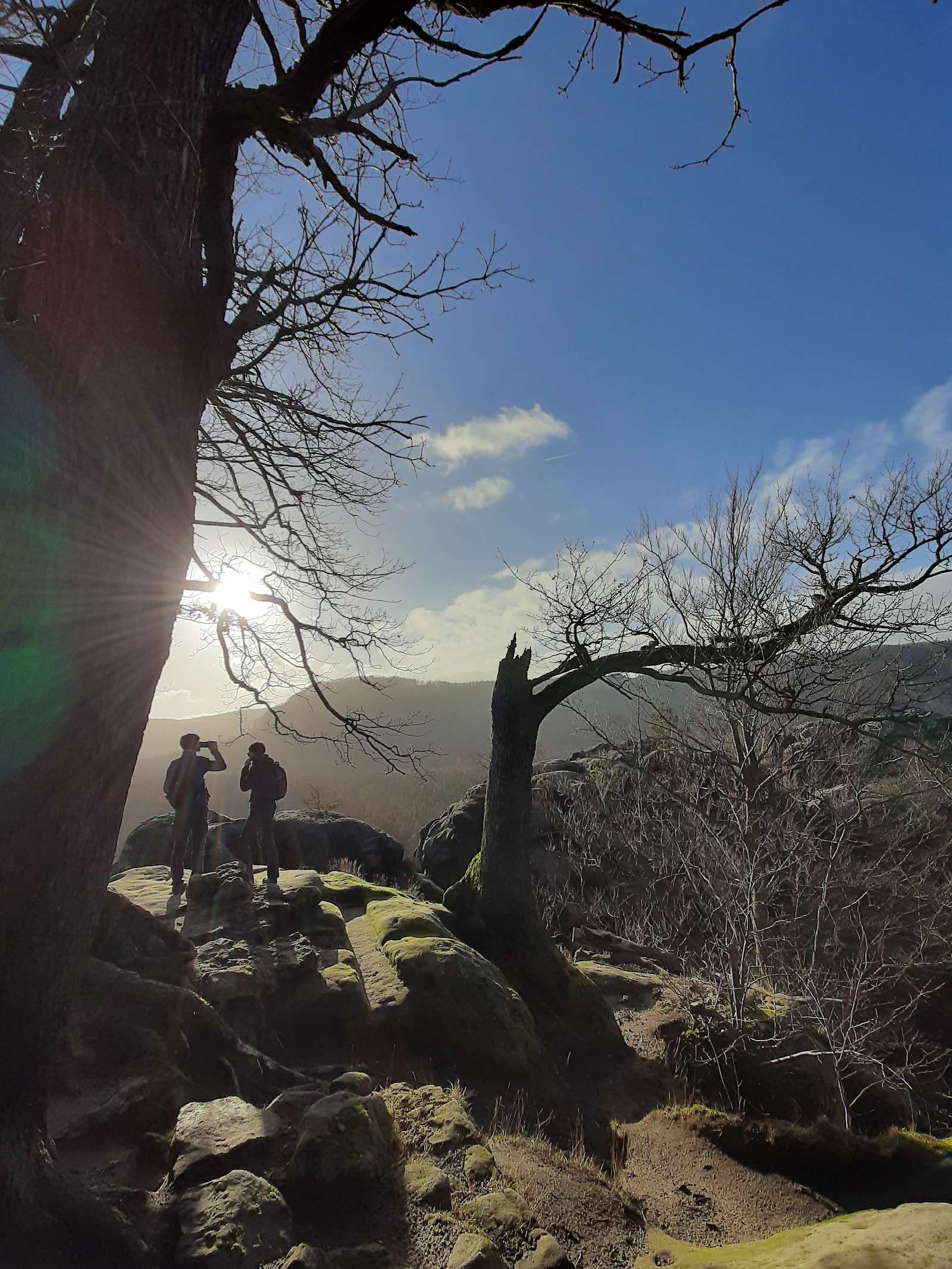
The winter months are perfect for a visit: fewer day tourists, peace and quiet and spectacular lighting conditions for your souvenir photos that you don't have in summer. The temperatures are ideal for hiking with good shoes and weatherproof clothing (be careful of mud, wind or rain, but very rarely snow). Therefore I can only recommend a hike at the beginning of the year. Be careful only in case of squalls at viewpoints or rock edges and wet leaves or wooden planks (the stairs, descents and ascents become more slippery).
So, first we take the S-Bahn to town of Bad Schandau and change there to the hiking bus in direction to the village Hinterhermsdorf.
The whole thing takes a little less than 1.5 hours to get there, the return trip then takes only 45 minutes, because you "walk in" the rest of the way. You might think that this takes too long if you only have one day available, but as I said, the trips through the National Park are beautiful, you could also take the historic Kirnitzschtal- Mountain Train as an alternative to the bus (just take the ferry over to the northern bank of the Elbe River from the Bad Schandau train station and get on the old mountain tram to the Lichtenhain waterfall) and then you could have spent this time again (the way is the goal). I recommend the whole effort nevertheless, because the cowshed, the second largest rock gate in the National Park, would otherwise be difficult to reach in one day, or that would degenerate into a "forced march".
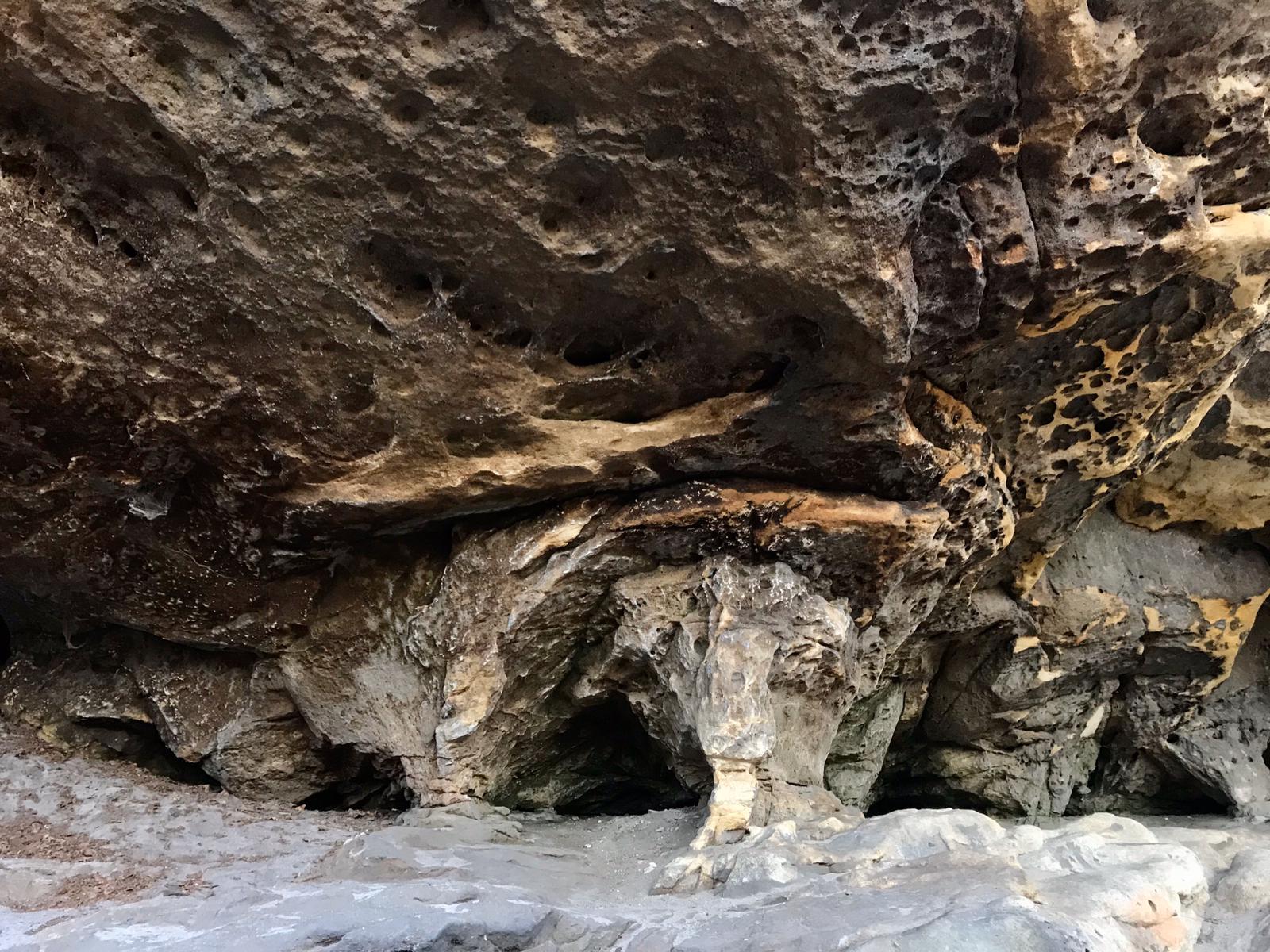
We get off at the Lichtenhainer Waterfall (Lichtenhainer Wasserfall), where you can also enjoy a beer in the adjacent pub or a visit to the toilet. The small sweet waterfall is definitely worth a photo, but there is still 10 minutes time for it. Then you walk along the road again towards the village Hinterhermsdorf and after a few meters on the right hand side you will find the entrance to the forest towards the cowshed, the rock gate, which was once used, so you assume, as a natural cave and shelter for your own cows. Many visitors have immortalized themselves on the walls here, the inscriptions go back to the beginnings of tourism in Saxon Switzerland. People have immortalized themselves here with their names as early as 1830 (please do not imitate!!).
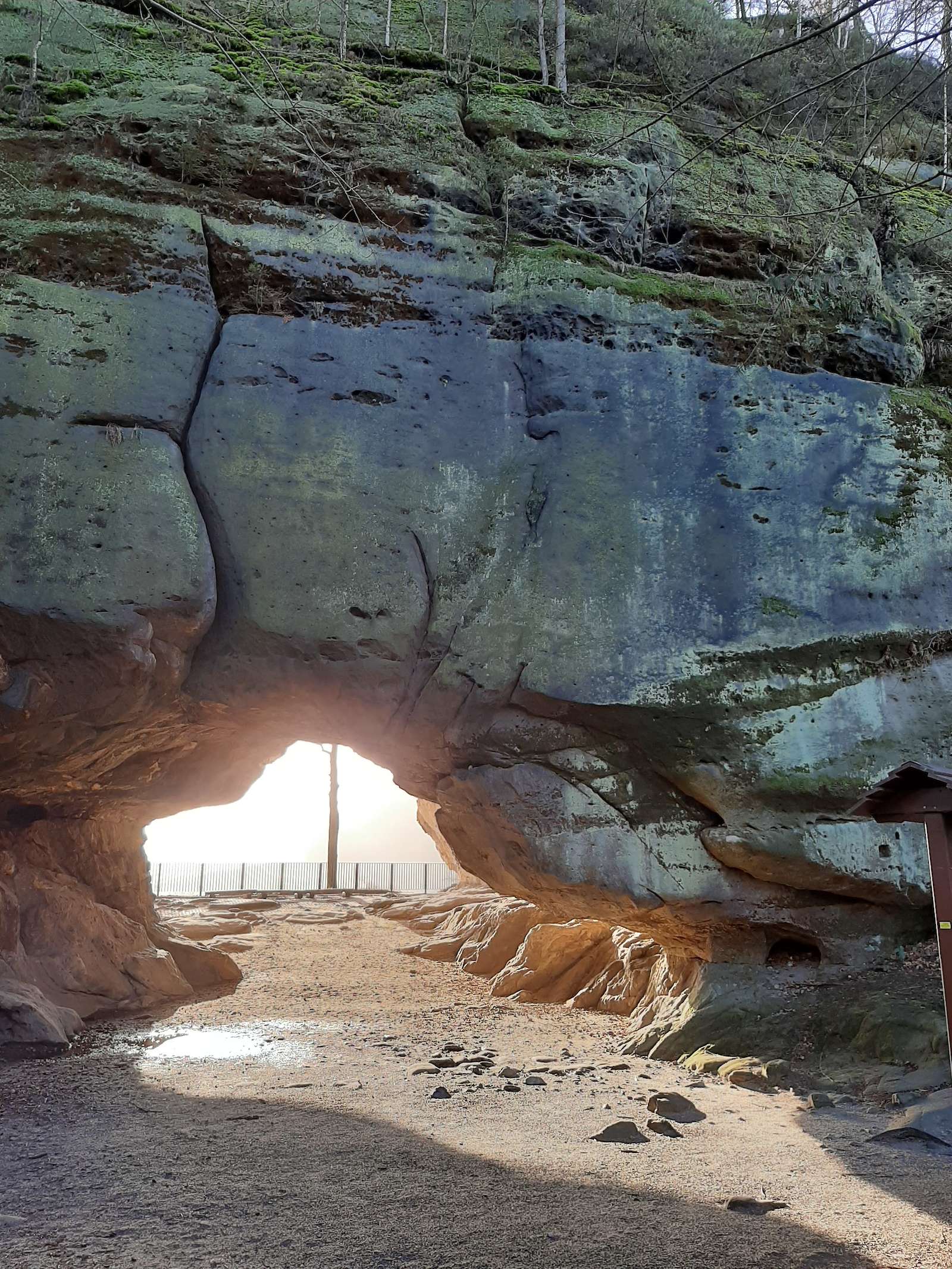
We leave the beautiful Kirnitzsch Stream and its valley and climb the steep mountain slope to the rock gate, the Cowshed. In the warmer months you will find a traditional mountain inn (since 1824) where you can stop for a bite to eat. This is very well visited in the summer months, tourists, mountaineers or day hikers are piling up here, now at the beginning of January there is almost not a soul to be seen here - they close during the winter months - fantastic! I take a few pictures and unpack my breakfast, the sun is shining so hard in my face that I can hardly see the view. The rock gate is presented so spectacularly - from both sides - I am at a loss for words.
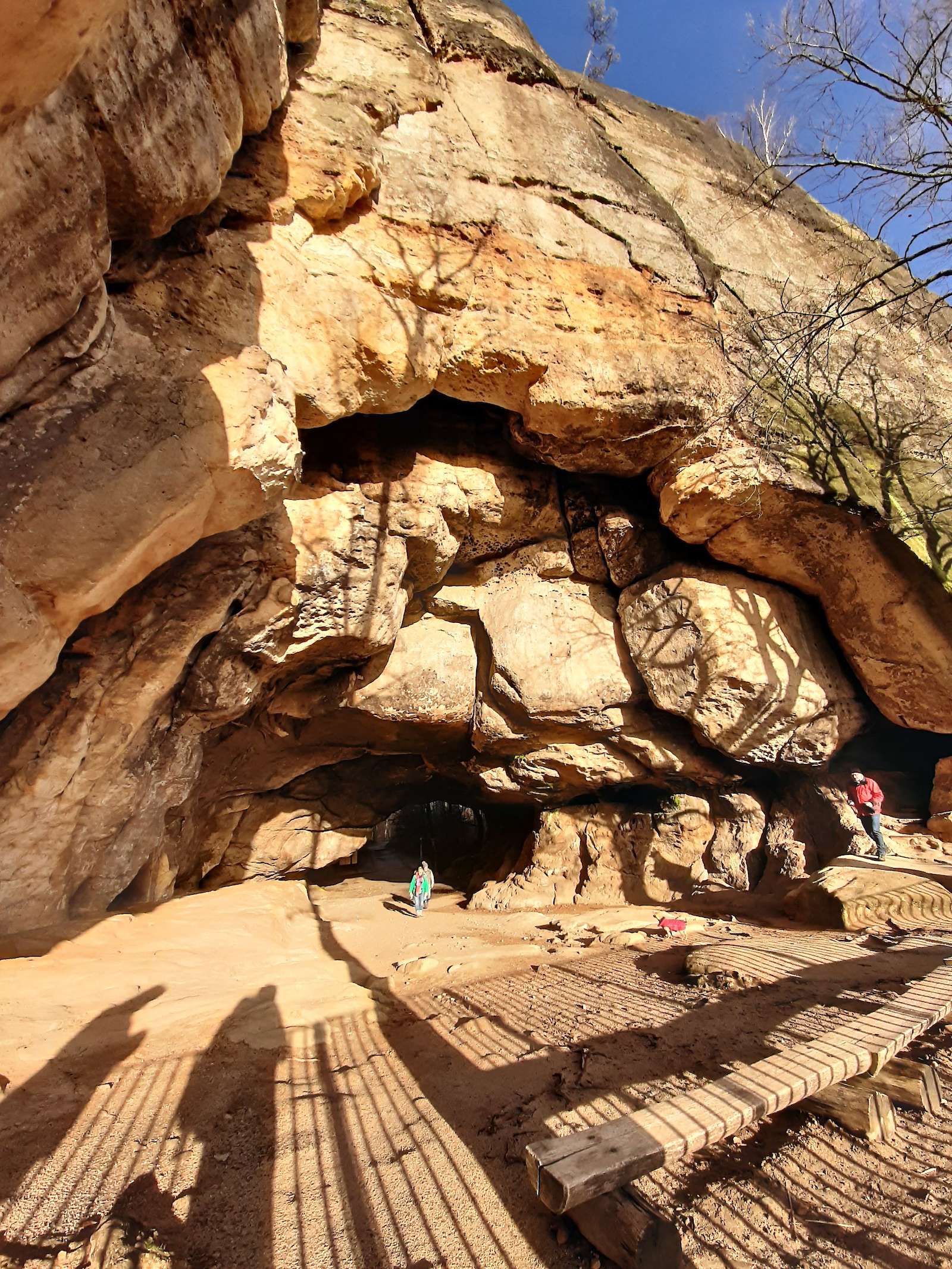
Right next to the Cowshed View there is an airy, dizzying narrow staircase, the Stairway to Heaven, after which you can climb up to the Cowshed. It gets super narrow, we take off our backpacks and climb up to airy heights. Again we enjoy the view.
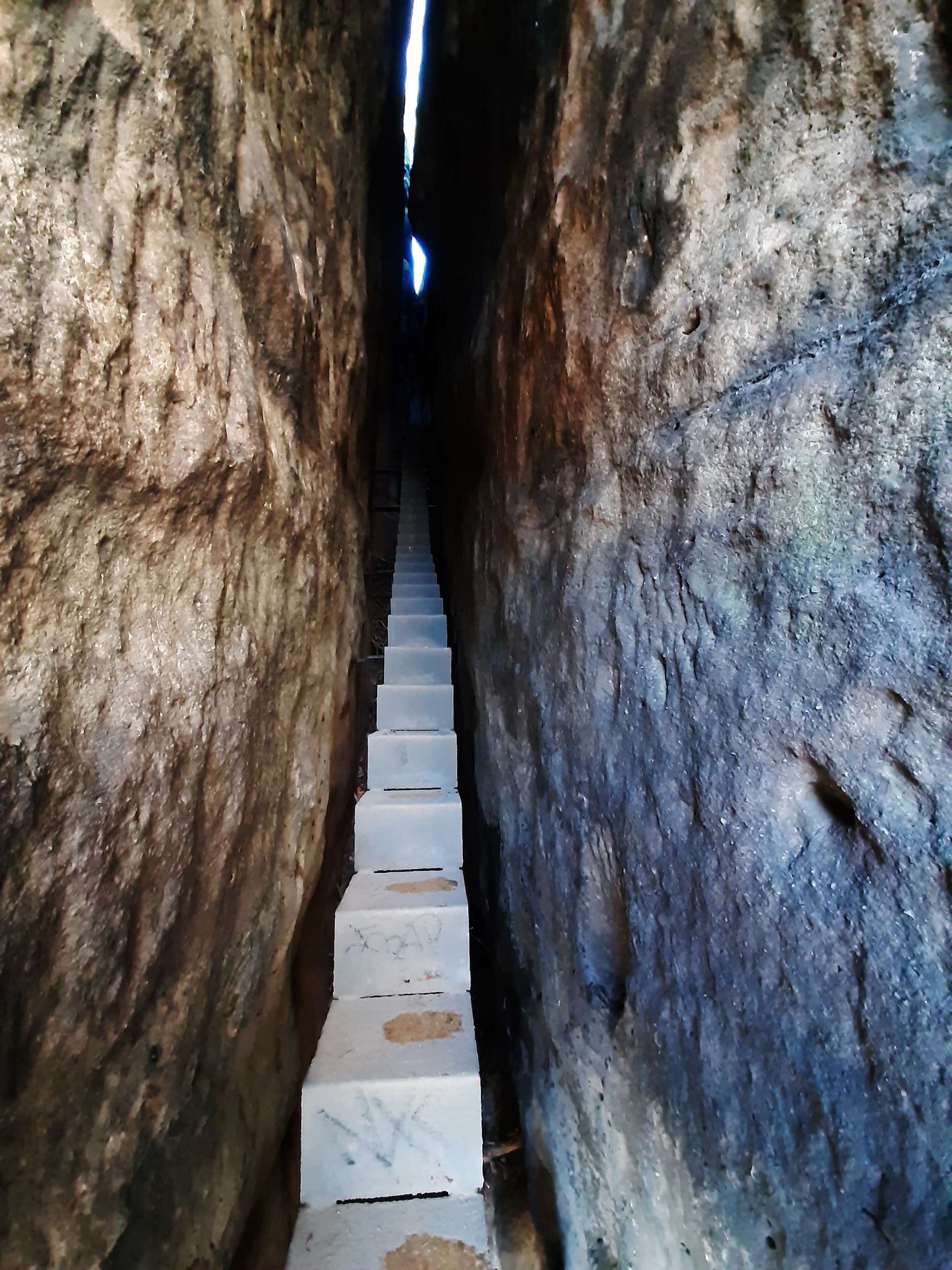
We take another turn around the rock gate, because I want to get a glimpse of the Cyclopean Wall. We pass this "rock balcony". One has to squeeze through a narrow tunnel and take a small ladder through the rock before reaching the opening at the rock face. This one lives up to its name. The dizzyingly high stone has a large dark cave eye in the middle. I climb through the narrow entrance and feel like a child again.
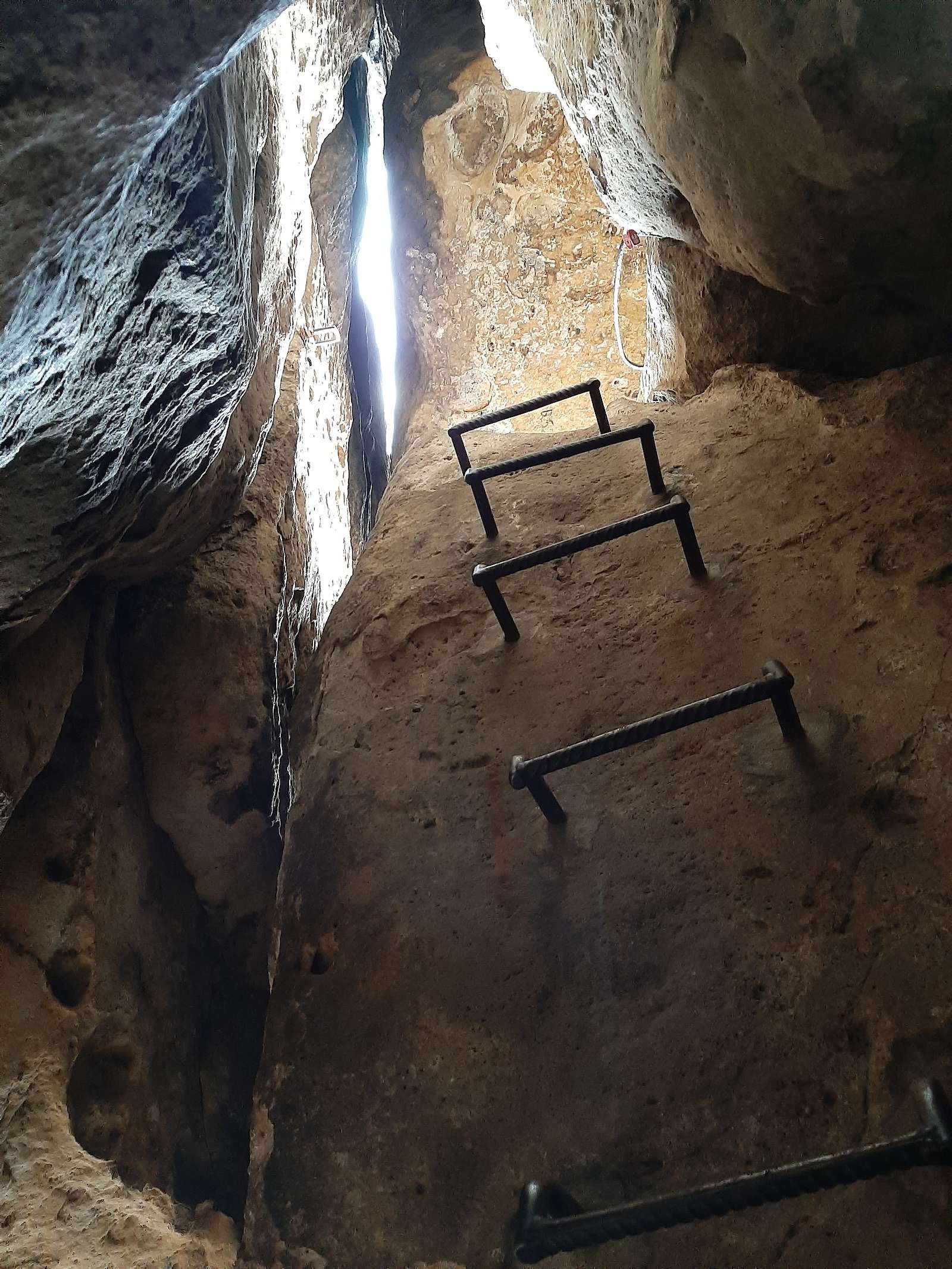
From the lower hiking trail you can also see the balcony and now I know why the wall is called that. This huge stone is impressive. I ask my friend Niall to take a picture quickly!
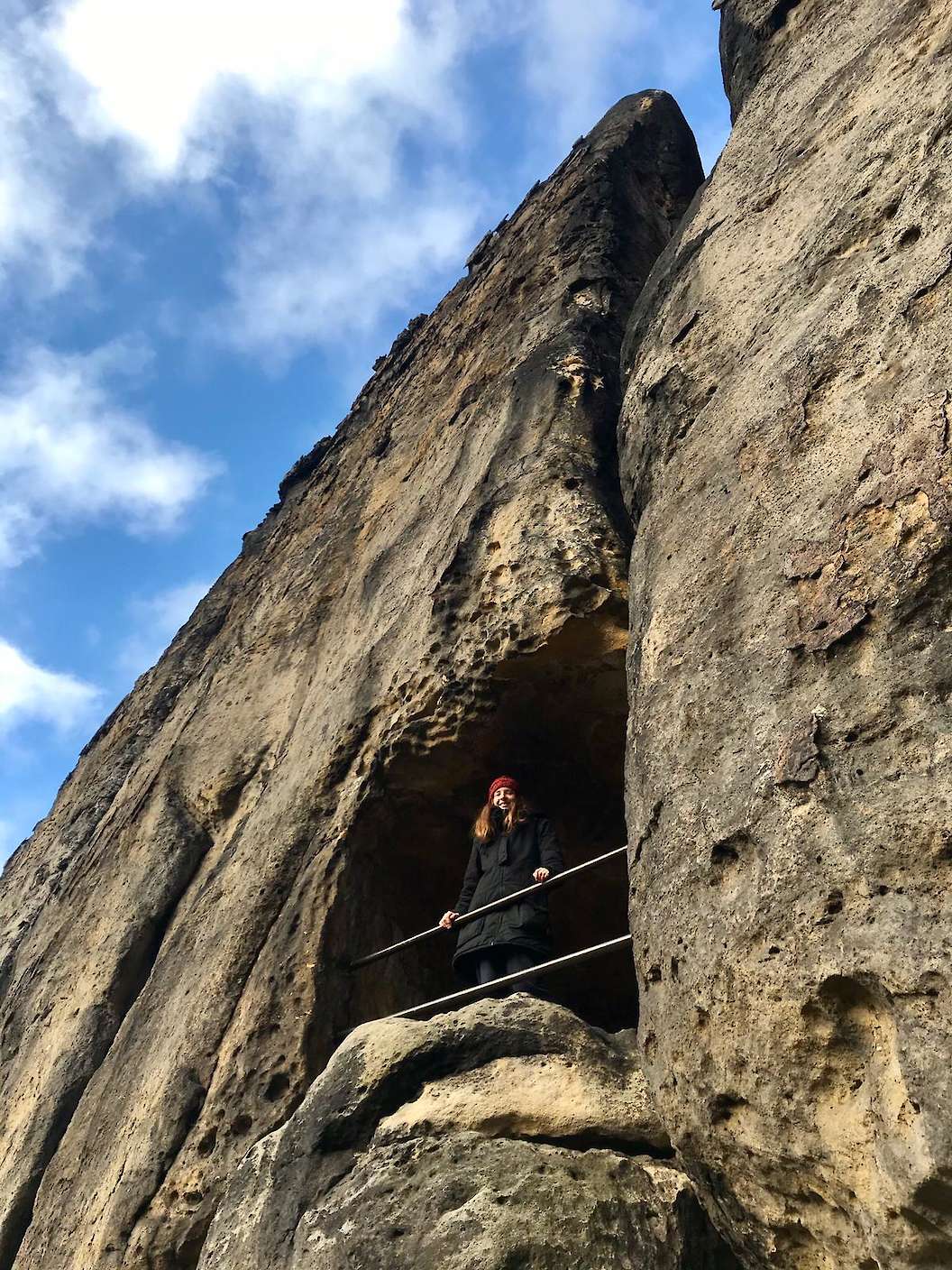
Then we finally walk along the Fremdenweg and slowly move away from this height down into the valley. This short section of forest is beautiful and relaxing.
The Dietrichsgrund, a wider gravel path and part of the official cycle path in the national park, offers a completely different picture. Here forestry work is done, but I also see trees again that are facing a slow death, they have lost all their bark, they have not survived the last two years of drought well. The forest is sick here, maybe that's why the harvester tracks and all the dead wood here, ready to be transported on.
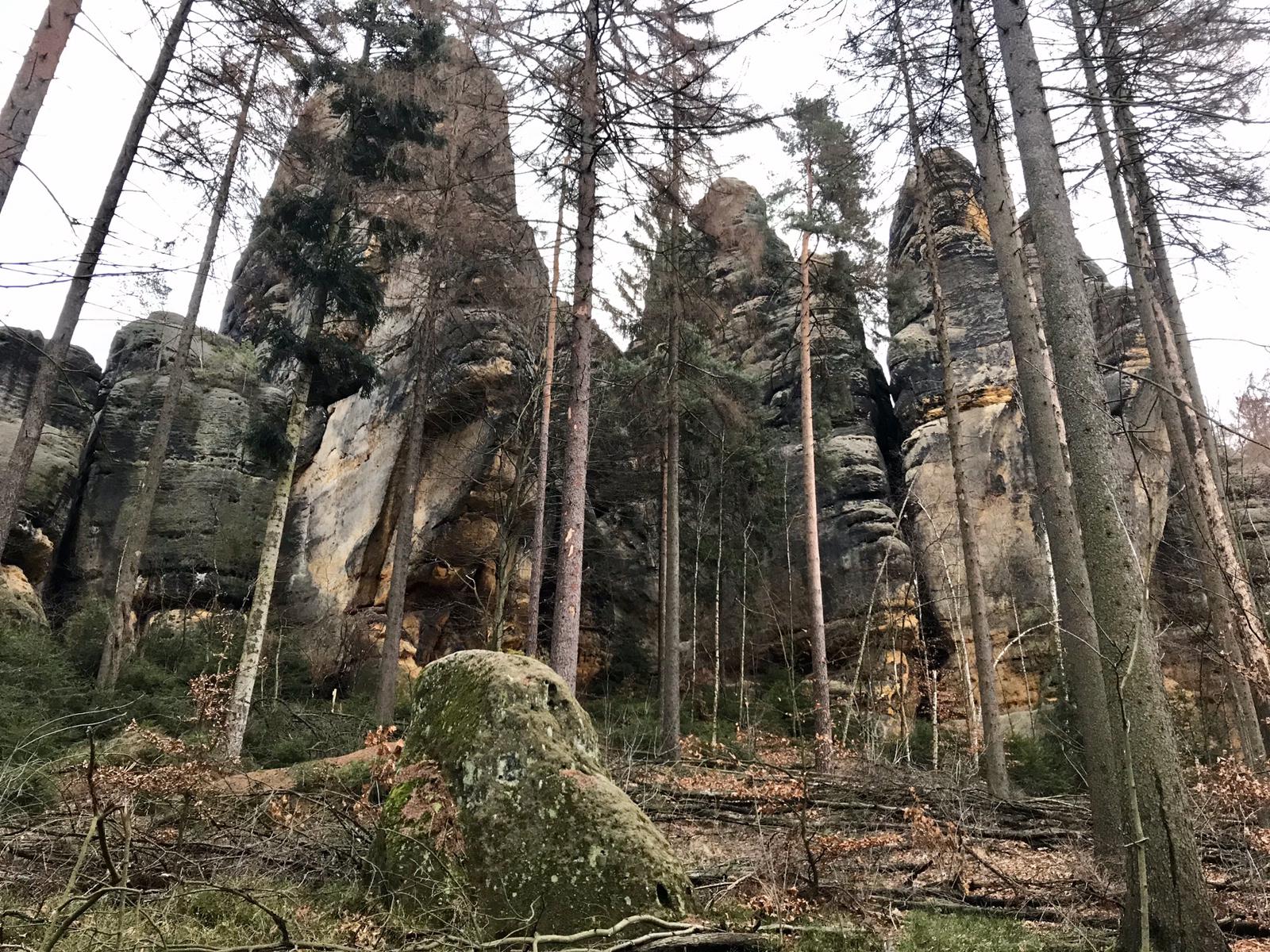
This picture has become increasingly common recently. The bark of the trees has flaked off due to the ongoing drought. Now it is time for mushrooms or bark beetles to feed. These trees do not do it for a long time. But the offspring is already ready. Photo: Niall
Immediately the Ranger from the Sachsenforst (Saxon Forests) passes by and waves to us friendly. One is aware of the problems, gets the extreme bark beetle infestation, young new trees grow everywhere in the undergrowth. Maybe we will make it. It will be difficult in the next few years, for the forest and the animals and lichens and ferns, but everyone can do their part for nature conservation. It is enough to walk through the forest with open eyes, enjoy the peace and quiet and fraternise inwardly with the forest. Please do not smoke in the forest any more. Even if it looks wet everywhere. You don't have to leave the paths either, otherwise you might step on something small and rare. I always pick up the rubbish left behind by other national park visitors, that satisfies me more than shopping. If you have the chance, talk to one of the nice rangers from Sachsenforst, who you see more and more often spontaneously in the forest. They also like to walk along, give tips and tell you something about the animals or plants.
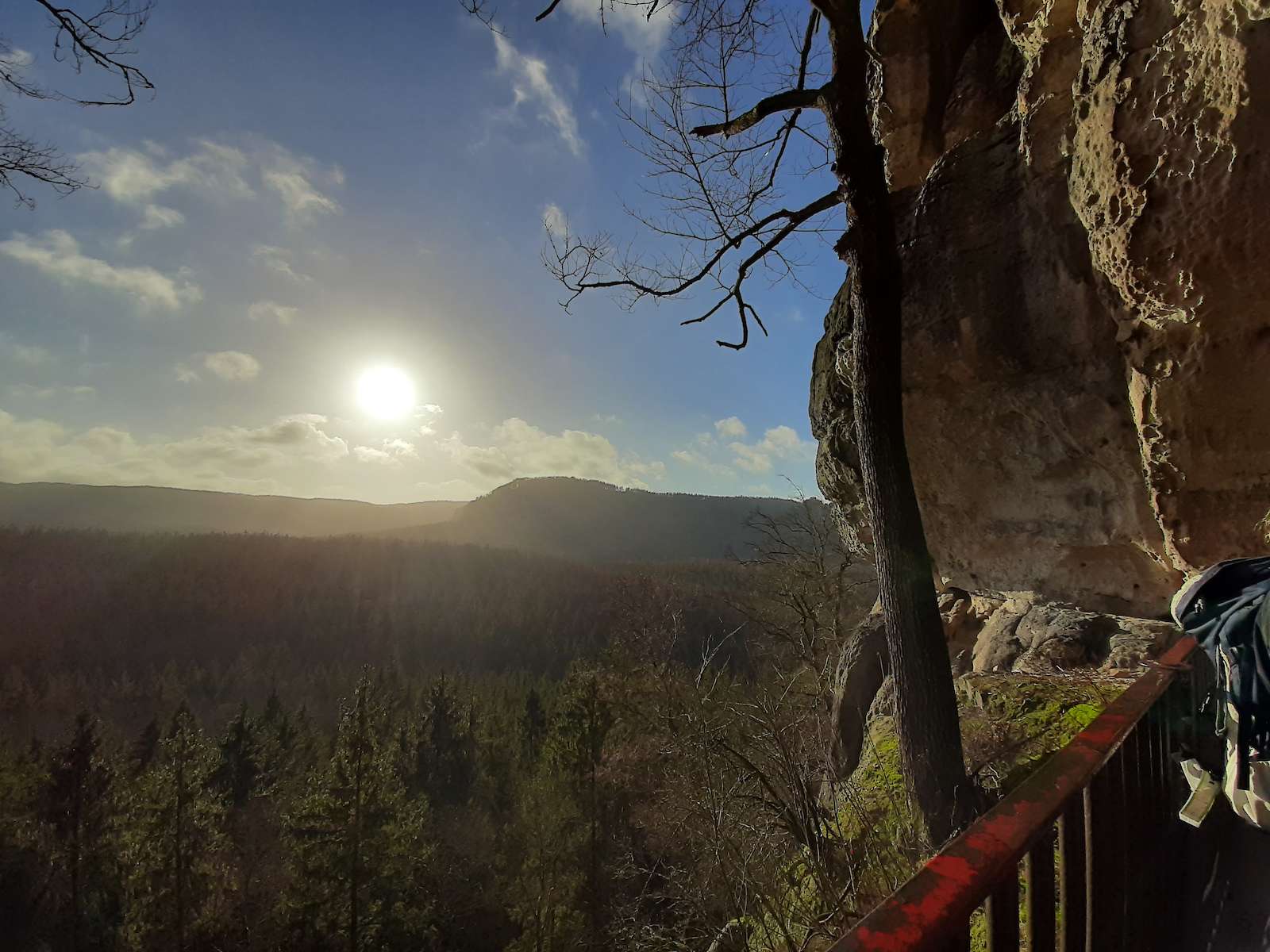
We continue hiking and enjoy the stretch north of the large rock massif, which forms the Monkey Stones (Affensteine) and later the Scratching Stones (Schrammsteine). There is one spectacular climbing wall after the other. One sees the worn yellow sandstone, fresh traces of fracture. Here climbing is clearly allowed, one impressive steep face after the other. Here you can also find isolated rock formations lying in the forest, sometimes spherical rocks. I imagine how they must have fallen from the slope above us only recently or once thousands of years ago...
On this route we often walk along parts of the painters' path (Malerweg). I realize why it is called that way, this romantic area must have impressed many generations before us. Niall says it looks a bit like maybe China. I have to agree with him.
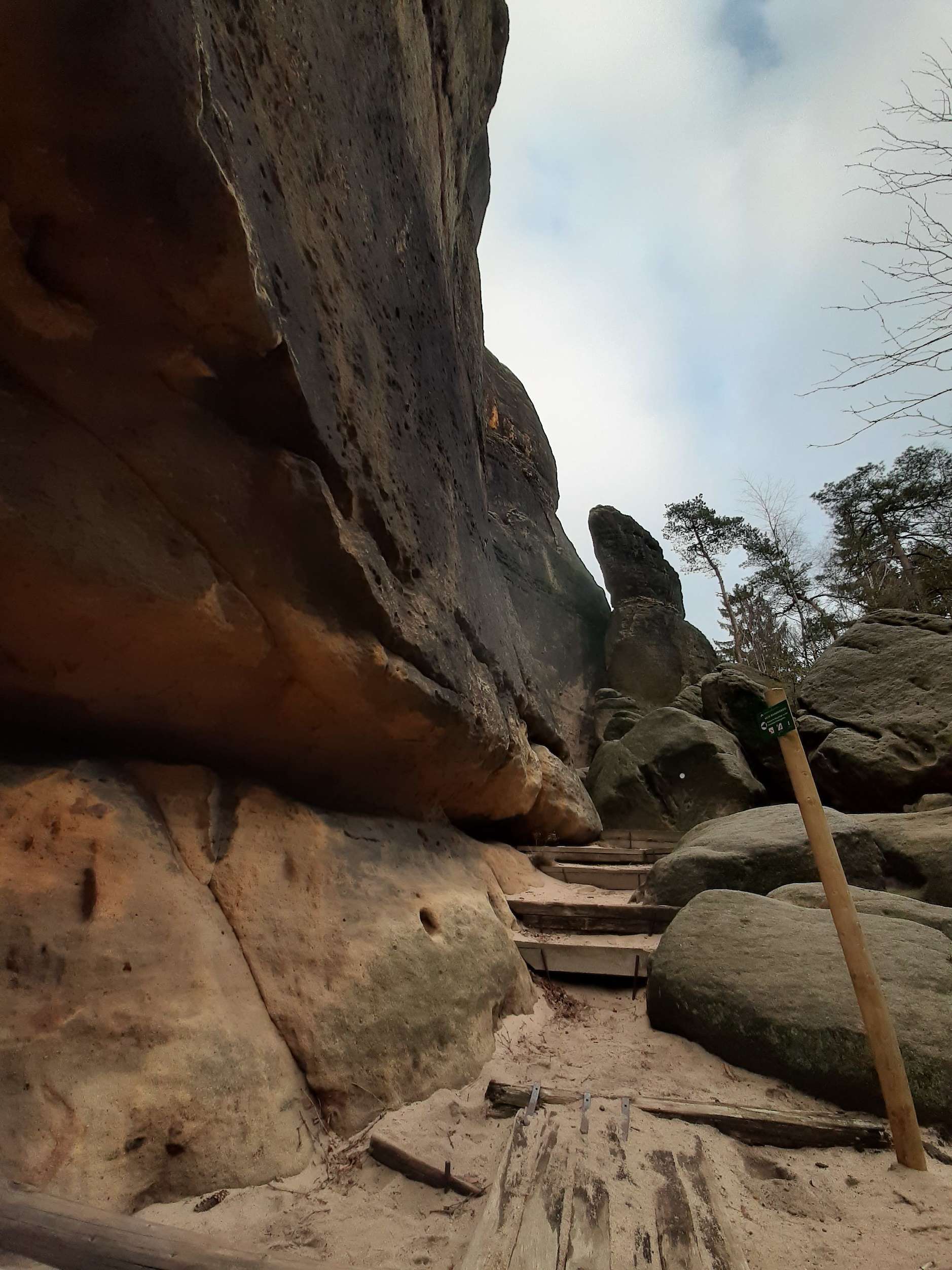
We enjoy the path that is now easy to walk and meander our way to the Scratching Gate (Schrammtor). One has to walk again in direction to the Scratching Stones (Schrammsteine) view in order to reach the so-called gate. This time we left out the view to the Scratching Stones (Schrammstein), but who likes can still take it from the northern side to the southern side over the Scratching Gate (Schrammtor).
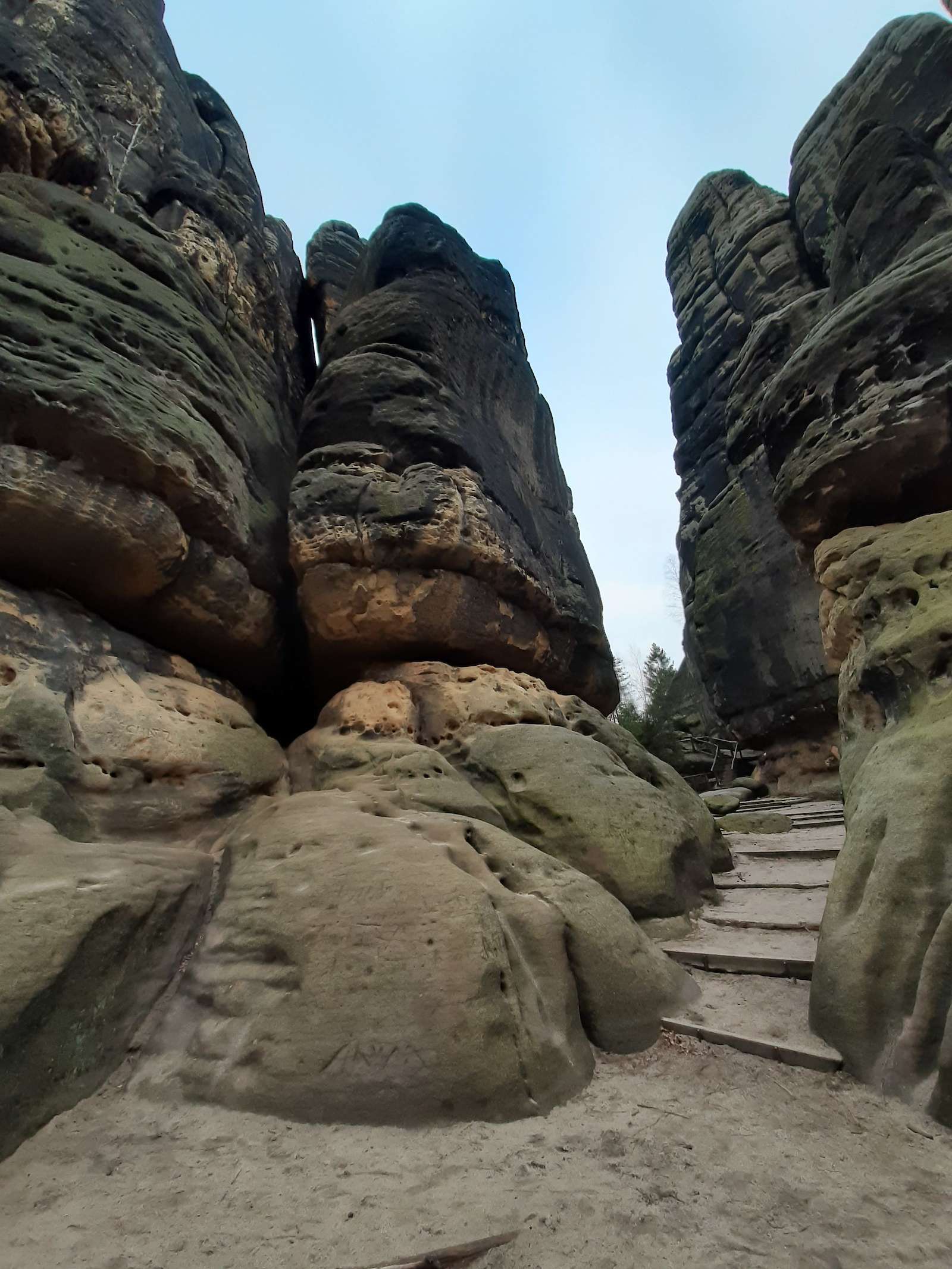
Tired but enchanted we set off again for Bad Schandau. There we treat ourselves to a delicious coffee and a piece of chocolate-raspberry cake, homemade, in the ice cream parlour. The shop is super full, it is the only shop that is not closed now at the beginning of January, although so many visitors of the health resort Bad Schandau are still on winter vacation. "Starting tomorrow," says the shop owner, "we will also be on holiday, today is the last day of opening."
Arrival
- S-Bahn line 1 (S1) in the direction of Schöna or Bad Schandau (every 30 minutes) to the S-Bahn stop Bad Schandau
- Change from the Bad Schandau train station to the adjacent hiking bus stop
- Bus line 451 direction Hinterhermsdorf from Bad Schandau railway station
- From Neustadt Station or Dresden Main Station it is best to start with one or more friends (then the costs are shared, everyone travels cheaper). The S1 runs every half hour and is therefore the easiest and most environmentally friendly way to get to the National Park. I generally do not recommend to travel by car. The train ride alone is worth the trip, because the train goes through the spectacular Elbe valley, which shows itself from the train from the town of Pirna from its most beautiful side.
You can buy the tickets at the vending machines in the train station (choose VVO- Verkehrsverbund Oberelbe here to get the cheap day tickets). Please don't forget to stamp your ticket at the top of the track (blue metal box on the platform). The ticket can then be used until 4 am the next day and can also be used for public transport in Dresden afterwards (ferries, bus, tram).
Tickets
- Day ticket 14 €
- Family day ticket (up to two adults and optionally also two children) 20 €
- Group ticket (3 to 5 persons) 29,50 €
- Ferry crossing on the Elbe including (the train ticket) the ferry in Krippen or Postelwitz back to Bad Schandau station
15.01.2020, 18:30 @ Jule
Categories: things to do · surroundings · travel · tips · activities // Tags: Malerweg · Kuhstall · Hiking in German National Park · Recommended Day Hikes in Saxon Switzerland National Park · Saxon Switzerland National Park · Transport in the Saxon Switzerland National Park · Waterfall Saxon Switzerland · Lichtenhainer Waterfall · Schrammtor · Sachsenforst · National Parks in Germany · Easy Hiking in Germany · painter's path · Bohemian Switzerland · Kirnitzschtal · Affensteine · Hiking near by Dresden · What to do in Dresden · Dresden Surroundings · Highlights in Dresden










